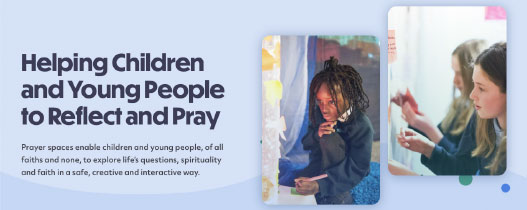
Prayer Spaces in Schools
Exploring life’s questions, spirituality and faith in a safe, creative and interactive way
“Our most basic task is to create environments and set conditions so people commune with the source of life, and bump into Jesus.
“Often it involves creativity. We’re so obsessed with words we’ve almost become immune to words. Often we need art and action. We need things to engage with. Things to engage our other senses that dip below the words sometimes.”
So says Phil Togwell, director of Prayer Spaces in Schools. Prayer Spaces in Schools enables children and young people, of all faiths and none, to explore life’s questions, spirituality and faith in a safe, creative and interactive way.
Phil says it often reveals to the school some pastoral need they weren’t aware of, as well as awakening teachers to the spirituality of the pupils.
“The number of times I’ve spoken to a member of staff prior to a prayer space, and heard them say something like, our kids aren’t going to be into this sort of thing, because they’re just not interested in spiritual stuff.
“And then after one lesson, they’re saying “Wow! I’m really surprised at some of the questions they’re asking and the things they’re talking about that they’ve experienced here in the prayer space, or even in their lives prior to this”.”
Furthermore, providing spiritual, moral, social and cultural learning is something schools in England and Wales are expected by Ofsted to provide. A prayer space helps a school deliver what it’s expected to.
It does so through a series of themed activities to help children and young people reflect and pray. The activities are deliberately designed to welcome them and invite them to participate, explains Phil. For example, one is called ‘Leave it there’. Pupils are invited to think about things they want to leave behind and then draw or write these things onto pieces of paper. They can screw them up and throw them in the bin to leave them behind and move on.
In a similar vein is ‘Bottle of Tears’, created in response to the coronavirus pandemic. It invites pupils to process their sadness and pain by dropping a ‘tear’ into a big bottle. They can also write or draw something sad onto a big teardrop and stick it onto the cross as a prayer.
‘Jumping for Joy’ is an activity that invites the children to jump on a trampette (a mini trampoline) and shout out the things that make them joyful. ‘The best way to help children to pray is to let them experience an emotion or feeling and then relate it to prayer’, states the website, on which there are hundreds more suggestions for activities.
“I think we thought our most basic task was just to tell people stuff,” continues Phil. “Most of our structures, our discipleship structures, our evangelism structures, even our pastoral structures are worded. And, of course, there’s a place for teaching and preaching.

“But with prayer spaces, we’re sitting in a room set up with post-it notes and mirrors and torn up cardboard. There’s nothing magical about any of this stuff. But we’re doing our best to set things up, pose questions, and pray like crazy that the Holy Spirit will fill this place.”
And fill this place it so often does. Phil notes that at the start of a week pupils will typically comment on what they see. However, by the end of the time the pupils and teachers working their way through the prayer space will comment on how peaceful it is, without any prompting.
“I’ve seen this so many times now. It’s like, ‘What can I see?’ at the beginning of the week. But by the end it’s ‘what can I feel?’
“The only explanation I’ve got is that the God who is everywhere has come here. These pupils and staff are trying to find words to describe the numinous of the mystery, the sense of the presence of God.
“Is it any wonder that lives get changed just a little bit as a result of that?”
Prayer Spaces in Schools
is part of the 24-7 Prayer movement, and began 14 years ago. To date it has tracked and supported thousands of prayer spaces in more than 30 nations, and at least a million children and young people have participated in them. Phil believes that the vast majority never prayed a personal prayer before they walked into that prayer space.
It is generally set up by a team from a local church or churches, and works best when there is already a ‘relational bridge’ between the church and school.
Phil explains: “I so often say to churches that inquire about running prayer spaces: are you already involved in a long-term relationship with that school? Are you praying for the school? And if not, are you committed to doing that? Because if you’re not, please don’t do a prayer space. But where there is a relational bridge, a prayer space is fantastic.”
 |
Click here to
download a pdf version of this article
Illustrations:
Banner image by Aaron Burden on Unsplash
Other photos by Prayer Spaces in Schools